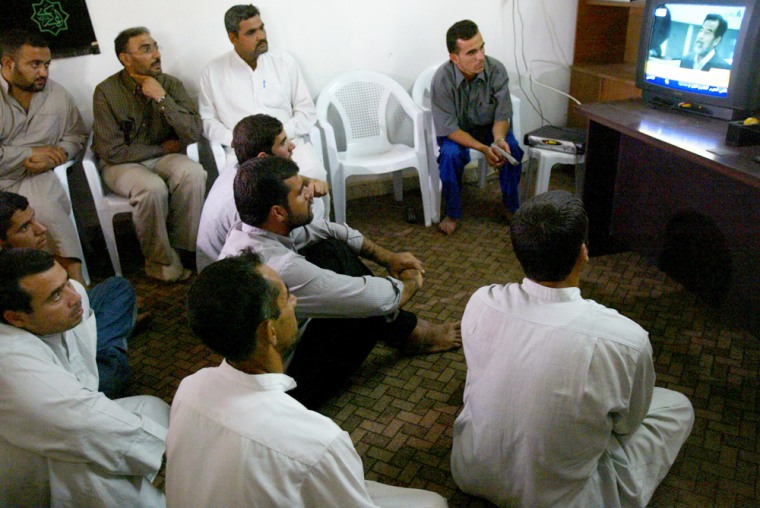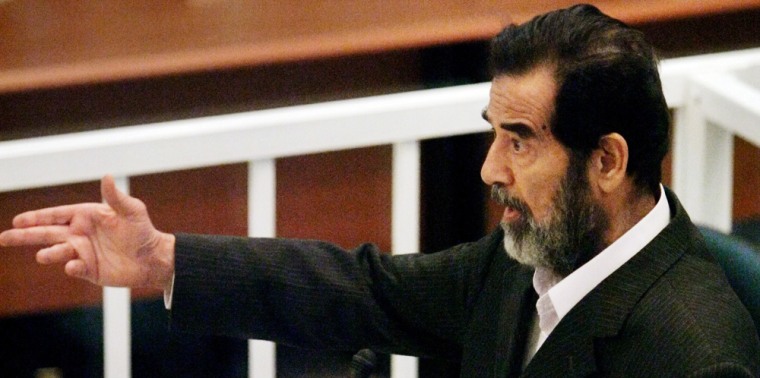A judge on Wednesday adjourned the trial of Saddam Hussein and seven co-defendants until Nov. 28, after Saddam pleaded innocent to murder and other charges, questioned the court’s authority and scuffled with guards.
The main reason for the adjournment was because some 30 to 40 witnesses had been too scared to show up, the presiding judge said.
“They were too scared to be public witnesses,” Rizgar Mohammed Amin told Reuters. “We’re going to work on this issue for the next sessions.”
A secondary reason was that the defense had requested a three-month delay to review the evidence.
Raad Jouhi, the investigating magistrate who prepared the case, told a news conference after the first session that the five-week adjournment was a “reasonable” response to the defense request.
The first session lasted just three hours, during which presiding judge Rizgar Mohammed Amin read the defendants their rights and the charges against them — which also include torture, forced expulsions and illegal imprisonment in a case involving the massacre of nearly 150 Shiites in 1982.
Amin then asked each for their plea. He started with the ousted dictator, saying “Mr. Saddam, go ahead. Are you guilty or innocent?”
Saddam — holding a copy of the Quran he brought with him into the session and held throughout — replied quietly, “I said what I said. I am not guilty,” referring to his arguments earlier in the session.
Amin read out the plea, “Innocent.”
The confrontation later became physical. When a break was called, Saddam stood, smiling, and asked to step out of the room. When two guards tried to grab his arms to escort him out, he angrily shook them off.
They tried to grab him again, and Saddam struggled to free himself. Saddam and the guards shoved each other and yelled for about a minute.
It ended with Saddam getting his way, and he was allowed to walk independently, with the two guards behind him, out of the room for the break.
First criminal trial of Arab leader
Many Iraqis and others across the Middle East were glued to their television sets to watch the first-ever criminal trial of an Arab leader.
The proceedings were aired with about a 20-minute delay on state-run Iraqi television and on satellite stations across Iraq and the Arab world. But technical quality was poor, with the sound cutting out frequently and the picture going blank several times.
But a too-busy President Bush did not watch, even as the White House hailed the trial as a key step in Iraq’s transition to a functioning democracy.
“Saddam Hussein is facing Iraqi justice,” White House spokesman Scott McClellan said. “The trial is a symbol that the rule of law is returning to Iraq. We hope this trial will help bring some closure for the Iraqi people to their country’s dark past.”
Neighboring Iran, which fought a 1980-88 war with Iraq, welcomed the trial’s start but said Saddam should be charged with invading Iran.
Still president?
Earlier, at the opening of the trial, the 68-year-old ousted Iraqi leader — looking thin with a salt-and-pepper beard in a dark gray suit and open-collared white shirt — stood and asked the presiding judge: “Who are you? I want to know who you are.”
“I preserve my constitutional rights as the president of Iraq,” Saddam said. “I do not recognize the body that has authorized you and I don’t recognize this aggression. What is based on injustice is unjust ... I do not respond to this so-called court, with all due respect.”
Amin, a Kurd, tried to get Saddam to formally identify himself, but Saddam refused. After several moments, he sat down.
Amin later read the charges against Saddam and his co-defendants, advising them they face possible execution if convicted in a 1982 massacre of nearly 150 Shiites in Dujail, Iraq, after a failed attempt on the former dictator’s life.
The chief prosecutor, Jaafar al-Mousawi, said the prosecution had videos of Saddam personally interrogating four Dujail residents soon after his motorcade was fired on.
Saddam countered that videotapes should not be admissible as evidence, insisting they can be altered and faked. The judge did not respond to his argument.
Prosecutors have said that they brought the Dujail case against Saddam first — rather than more notorious atrocities in which far more people were killed — because they had more solid, easy-to-gather evidence on Dujail, including documents and videos showing the then-leader's role.
Saddam and his co-defendants — top officials and lower civil servants from his Baathist regime — were called in one by one into the courtroom.
After sitting, Saddam greeted his co-defendants, saying “Peace be upon you,” sitting next to co-defendant Awad Hamed al-Bandar, former head of Iraq’s Revolutionary Court.
The other defendants include Saddam’s former intelligence chief Barazan Ibrahim, former vice president Taha Yassin Ramadan and other lower-level Baathist civil servants.
Ramadan also refused to identify himself to the judge. “I repeat what President Saddam Hussein has said,” he added. The other defendants agreed to state their names.
Irony of trial setting
A panel of five judges will both hear the case and render a verdict in what could be the first of several trials of Saddam for atrocities carried out during his 23-year-rule.
The trial is taking place in the marble building that once served as the National Command Headquarters of his feared Baath Party. The building in Baghdad’s Green Zone — the heavily fortified district where Iraq’s government, parliament and the U.S. Embassy are located — was ringed with 10-foot blast walls and U.S. and Iraqi troops. Several Humvees and at least one tank were deployed outside, and U.S. soldiers led sniffer dogs around the grounds, looking for explosives.
The identities of judges have been a tightly held secret to ensure their safety, though Amin’s name was revealed on Wednesday just before the trial began.

Many Iraqis who watched the trial eagerly awaited the chance to see the man who ruled Iraq with unquestioned and total power held to justice.
Salman Zaboun Shanan, a Shiite construction worker, sat with his family at home in Baghdad’s Shiite neighborhood of Kazimiyah, having taken the day off from work to watch the trial. “I hope he is executed, and that anyone who suffered can take a piece of his flesh,” said Shanan, who was imprisoned during Saddam’s rule.
But across the Tigris River in the mainly Sunni Arab district of Azamiyah, some were embittered over the trial of Saddam, whose regime was dominated by Sunni Arabs who have now lost their power.
“Saddam is the lesser of evils,” said Sahab Awad Maaruf, an engineer, comparing Saddam to the current Shiite-Kurdish led government. “He’s the only legitimate leader for Iraqis.”
There are also fears of attacks by insurgents — who are thought to include members of Saddam’s regime — to disrupt the trial.
‘Victors’ justice’ fair?
The world will be watching Saddam’s trial to see whether Iraq’s new Shiite and Kurdish leaders can rise above politics and prejudice and give the former dictator a fair hearing. Human rights group have criticized the government for trying to influence the trial and that considerable U.S. logistical and financial aid to the tribunal could lend credibility to charges that it will mete out “victors’ justice.”
The court is also operating not only under its own rules — laid out when the court was created in 2003 while Iraq was still run by American administrators — but also by a 1971 Saddam-era criminal law that some have criticized as not up to international standards.
That law says the judges can issue a guilty verdict if they are “satisfied” by the evidence — seen as lower standard of proof than “convinced beyond a reasonable doubt.”
Saddam’s defense lawyer Khalil al-Dulaimi said Tuesday he would challenge the special tribunal’s competence to try the case, arguing that Saddam remains the legitimate president and the court is illegal, because it was created under U.S. occupation.
Saddam was ousted after U.S.-led forces swept into Iraq in March 2003 and marched in to Baghdad. He has been held since American forces found him hiding in a celler outside Tikrit, Iraq on Dec. 13, 2003 in a U.S. detention facility at Baghdad International Airport.
Prosecutors are preparing other cases to bring to trial against Saddam and his officials — including for the Anfal Operation, a military crackdown on the Kurds in the late 1980s that killed some 180,000 people; the suppression of Kurdish and Shiite revolts in 1991; and the deaths of 5,000 Kurds in a 1988 poison gas attack on the village of Halabja.
If a death sentence is issued in the Dujail case, it is unclear whether it would be carried out regardless of whether Saddam is involved in other trials. He can appeal a Dujail verdict, but if a conviction and sentence are upheld, the sentence must be carried out within 30 days. A stay could be granted to allow other trials to proceed.
